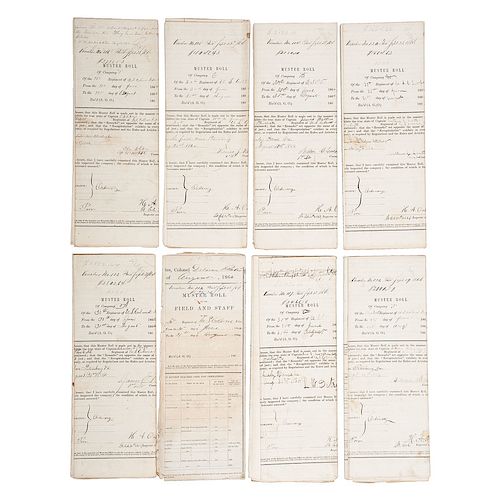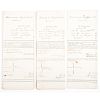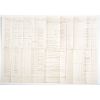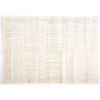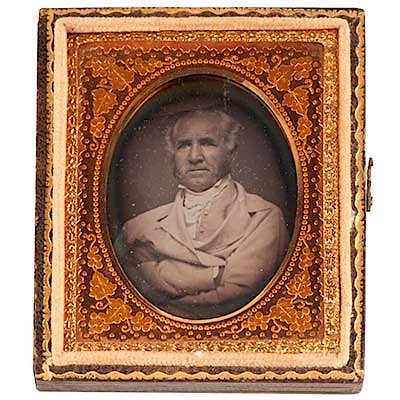Set of 11 Muster Rolls for 30th USCT, July-August 1864
About Seller
6270 Este Ave.
Cincinnati , OH 45232
United States
With offices in Cincinnati, Cleveland and Denver, Cowan’s holds over 40 auctions each year, with annual sales exceeding $16M. We reach buyers around the globe, and take pride in our reputation for integrity, customer service and great results. A full-service house, Cowan’s Auctions specializes in Am...Read more
Two ways to bid:
- Leave a max absentee bid and the platform will bid on your behalf up to your maximum bid during the live auction.
- Bid live during the auction and your bids will be submitted real-time to the auctioneer.
Bid Increments
| Price | Bid Increment |
|---|---|
| $0 | $25 |
| $500 | $50 |
| $1,000 | $100 |
| $2,000 | $250 |
| $5,000 | $500 |
| $10,000 | $1,000 |
| $20,000 | $2,500 |
| $50,000 | $5,000 |
| $100,000 | $10,000 |
About Auction
Nov 16, 2018
Cowan’s Fall American History: Premier Auction features over 200 lots including early photographs, documents, manuscripts, broadsides, flags, and more dating from the Revolutionary War period to the mid-20th Century, many representing important landmark moments in American history. Cowan's Auctions dawnie@cowans.com
- Lot Description
Set of 11 Muster Rolls, 30 June through 31 August 1864 for the 30th USCT. Rolls for Cos. A, B, C, D, E, F, G, H, I, K and Field and Staff (Vouchers 112 - 122, paid Sept. 28-29). Field and Staff did not appear to be faring well. There are 9 Commissioned staff listed (Col., Lt. Col., Maj., Adj., QM, Surg., 2 Asst. Surgs. and Chaplain), of which six were sick, wounded, or otherwise absent (Col. - wounded, out since Aug. 3; Major - wounded since July 30; QM detached service; Surg. - Special Duty at Div. Hosp. since June 30; first Asst. Surg. sick since June 23; Chaplain - sick since July 22).
As was typical, a significant number of men were out sick. Co. A lists 34 on duty, 25 sick in their summary, plus 4 KIA July 30, 2 DOW in field hospital, and 4 MIA Petersburg.
Co. B - 42 on duty, 25 sick; 6 MIA since July 30th (Petersburg);
Co. C. - 37 on duty, 26 sick; 6 possibly POW;
Co. D - 29 on duty, 31 sick; 9 missing at Petersburg;
Co. E - 25 on duty, 25 sick; 10 MIA at "The Crater", plus one listed as KIA at the "Crater" and one KIA by sharp shooter in the trenches Aug. 1, many more wounded at "Crater";
Co. F - 28 on duty, 33 sick; 2 KIA, 2 DOW and 8 MIA at Petersburg
Co. G - 38 on duty, 20 sick; 1 KIA, 3 DOW and 4 MIA at Petersburg
Co. H - 24 on duty, 19 sick; 1 KIA, 3 DOW and 5 MIA at Petersburg (missing one officer)
Co. I - 28 on duty, 22 sick; 1 DOW and 6 MIA at Petersburg
Co. K - 20 on duty, 21 sick; 2 KIA, 2 DOW (City Point Hosp.), 3 MIA at Petersburg
In addition, of course, many of those listed as "sick" were likely the wounded at Petersburg.
The muster rolls give quite a bit of information on these men. Many have remarks beside their names, particularly if they were sick, wounded, or killed. Most have some, however brief, summary of the Regiment's actions in the previous two months, with the focus, of course, on Petersburg since they were there most of this time. Too often the captains did not even bother to put these notes on the rolls.
Petersburg, Virginia was the "gateway" to Richmond, with four rail lines running through the town from various points to the South, then on to the Confederate capital. It was the route by which Richmond received most of their supplies. The Union came to see Petersburg as the key to the capture of Richmond. Although nearly half of the Civil War battles were fought in and around the Petersburg-Richmond area, the organized push to capture Petersburg came in the late spring and early summer of 1864. The early June attempt to capture the city failed, setting into a stalemate that, although usually called the "Siege of Petersburg" in the histories, was not a traditional siege, but rather trench warfare, with both sides digging in and constructing fortified positions.
Lieut. Col. Henry Pleasants, in command of the 48ty Pennsylvania Infantry, part of Major General Burnside's IX Corps, had been a mining engineer in civilian life and proposed digging a tunnel under the Confederate defenses and exploding charges underneath the line. The dual purpose was to kill as many defenders as possible and open up the defenses so Federal troops could stream in behind them, and take Petersburg before the Confederates could reorganize.
Although skeptical, Lieut. General Grant and Major General Mead allowed the plan to go forward and digging began in late June. The latter generals mostly saw the project as something to keep the men busy since boredom had set in in the trenches. As such, they did not allocate the resources necessary to carry out the plan as Pleasants envisioned it.
While the digging was proceeding, two brigades of "Colored Troops" under Brig. Gen. Ferrero were training to lead the assault, one of the few times such training was undertaken (and possibly also a way to occupy the men). The 30th USCT was part of the 1st brigade under Lt. Col. Joshua Sigfried along with the 27th, 39th and seven companies of the 43rd USCT. The 2nd brigade was composed of the 19th, 23rd, 29th and 31st USCT under Col. Henry Thomas.
Despite this training and preparation, on the day before the attack, General Meade ordered Burnside not to use the colored troops, claiming there would be repercussions if the plan did not succeed. Others have claimed that Meade did not have any confidence in the black troops to carry out the assignment. Still others have claimed that Meade did not want Burnside, whom he did not like at all, to get the glory if the plan was successful, but rather wanted to grab it for himself. Whatever the case (or all of these), this last-minute change in the plans doomed the attack.
When no one volunteered to lead the assault, Burnside had three division commanders draw lots. The 1st Division was selected, but the men received no information on what was expected. The mine was also filled with only half of the requested explosives, and given poor-quality fuse, which had to be spliced together.
The explosion was to occur between 3:30 and 3:45 am on July 30. The fuse was lit, and they waited. After a long delay, two men from the 48th PA went in and found the fuse went out at one of the splices. They made a new one and relit that. At 4:44 am, the explosion occurred in a shower of earth, men and guns, creating a crater 170 feet long, 100-120 feet wide and 30 (or more) feet deep. The replacement troops ran down in the crater, seeing it as a big rifle pit in which to take cover, much to the dismay of the watching USCT regiments. The delay in entering the gap in the lines gave the Confederates the needed time to regroup, line up along the edges of the crater, and pick off the Union troops who could not now escape from the pit.
Then to make matters worse, Burnside sent in Ferrero's men, who knew there was little hope, but in a show of bravery, they followed orders and ran into "The Crater." The black troops had been disappointed that they were replaced, since they seem to have thought that the plan might work as proposed, and they could be key in capturing Petersburg and ultimately ending the war, and showing their white counterparts that they were equal soldiers in every respect (skill, bravery, etc.). In the aftermath, Grant famously wrote to Henry Halleck that "It was the saddest affair I have witnessed in this war."
As noted by Forstchen and Gingrich, "[The men of the IX Corps] ...saw it as a chance to prove their mettle to the world, and many speculated that perhaps here they would win the war and a glorious place in history....
"The men of the 4th Division, IX corps, 4,000 strong, who went forward that day were but months earlier either slaves or "freemen," who in nearly every state held no true rights of citizenship. Yet they rose to the cause. They believed the promise of Frederick Douglass that a rifle in their hand and in Army blue, they would forever win full citizenship for themselves and their descendants.... Few recall these men now, and even fewer know their names."
These rolls relate those names, those who fought bravely and some who gave their "last full measure of devotion."
Forstchen, William R. and Gingrich, Newt. "At Battle of the Crater, black troops prove their courage." The Washington Post, April 24, 2014.
Muster rolls in very good condition. The center folds are weakening, but holding. The wrapper that held the group together has suffered from the group being taken out and put back many times.Condition
- Shipping Info
-
Buyers are required to pay for all packing, shipping and insurance charges. Overseas duty charges are the responsibility of the successful Bidder. Be aware that for larger and/or valuable items, shipping charges can be substantial. - If there is no shipping amount on listed your invoice, you will need to make arrangements to pick up or ship your purchase through an alternative shipping company. Our shipping department can be contacted at 513.871.1670 (ext. 219) or email shipping@cowans.com. - Shipping charges include insurance for your order while in transit. If you have private insurance we will adjust your charge to include only packing and shipping. - Please allow 14 – 21 days after payment to package and ship your purchase as carefully as possible.
-
- Buyer's Premium



 EUR
EUR CAD
CAD AUD
AUD GBP
GBP MXN
MXN HKD
HKD CNY
CNY MYR
MYR SEK
SEK SGD
SGD CHF
CHF THB
THB